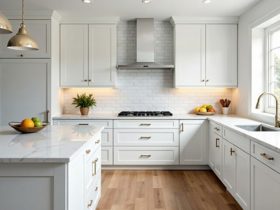The Craft Of Seamless Room Integration: Tips For Flawless Additions

Flawless room integration is crucial when it comes to home renovations or additions. Whether you are expanding a room or adding a new one, it is important to seamlessly blend the new space with the existing one. This not only enhances the overall aesthetics of your home but also creates a cohesive and functional living environment.
Maximizing space in tiny homes is a creative challenge that often leads to ingenious solutions. One effective way to enhance your compact living area is by considering thoughtful room expansions. By seamlessly integrating additional space, homeowners can enjoy a more versatile and comfortable environment. Companies like My Home Builders, Inc. offer a premier destination for top-notch room additions in Los Angeles and high-quality room additions in Glendale, CA, allowing you to tailor your tiny house to your specific needs.
Moreover, when looking for top-tier room additions in North Hollywood, CA, or high-quality room expansions in Woodland Hills, CA, professional services like My Home Builders, Inc. can turn your compact home into a more functional and spacious sanctuary. With their expertise in crafting seamless room additions, they provide solutions that merge seamlessly with your existing structure, optimizing every inch of your tiny home for convenience and comfort.
1. Assessing the Existent Space
Before beginning a room addition project, it is important to assess the existing space thoroughly. This involves considering the layout, size, and functionality of the existing rooms. By understanding the current state of your home, you can better plan for the new addition and ensure a seamless integration.
Take measurements of the existing rooms and identify any structural considerations that may impact the new room integration. Consider factors such as load-bearing walls, electrical wiring, and plumbing systems. By assessing these details in advance, you can avoid any surprises or complications during the construction process.
2. Establishing a Design Theme
Creating a cohesive design theme is essential for achieving a seamless room integration. The design theme should complement the existing style of your home while also adding a fresh touch to the new addition. This can be done through careful selection of colors, materials, and architectural details.
Consider the architectural style of your home and choose a design theme that aligns with it. Whether you prefer a modern, traditional, or eclectic style, ensure that the new addition harmonizes with the overall aesthetic of your home. This will create a visually appealing and unified space.
3. Choosing the Right Materials and Finishes
Assessing the Material Options
The choice of materials for your room addition plays a significant role in achieving a seamless integration. Consider materials that are not only visually appealing but also durable and compatible with the existing structure. Whether you opt for wood, stone, tile, or other materials, make sure they match the overall design theme and color palette.
It is also important to consider the functionality and maintenance requirements of the materials. For example, if you are adding a bathroom, choose materials that are resistant to moisture and easy to clean.
Considerations for Choosing the Right Finishes
The finishes in your room addition, such as paint, wallpaper, and flooring, can significantly impact the overall look and feel of the space. When choosing finishes, consider factors such as durability, ease of maintenance, and compatibility with the existing finishes in your home.
Coordinate the finishes in the new addition with the existing finishes to maintain consistency throughout your home. This can be achieved through matching colors, textures, or patterns. By choosing the right finishes, you can create a seamless transition between the old and new spaces.
Balancing Aesthetics and Functionality
When integrating a new room into your home, it is important to strike a balance between aesthetics and functionality. The new addition should not only look visually appealing but also serve a practical purpose. Consider the layout and flow of the space to ensure it meets your functional needs.
For example, if you are adding a home office, consider the placement of electrical outlets, storage space, and natural light. By considering both aesthetics and functionality, you can create a seamless integration that enhances your daily living experience.
4. Incorporating Proper Lighting
Lighting plays a crucial role in room integration as it sets the mood and enhances the overall ambiance. Ensure that the new addition has adequate lighting that complements the existing spaces. Consider a mix of natural light, ambient lighting, and task lighting to create a well-balanced and functional space.
During the planning phase, assess the natural light sources in the existing rooms and strategically position windows or skylights in the new addition to maximize natural light. Additionally, consider the placement of light fixtures and the type of lighting to create a cohesive and visually appealing atmosphere.
5. Ensuring Structural Integrity
When integrating a new room into your existing home, it is essential to ensure structural integrity. This involves working with a professional contractor or architect who can assess the structural requirements of the addition and make any necessary modifications.
Avoid compromising the structural integrity of your home by hiring professionals who are experienced in room additions. They will ensure that the new room is properly supported, meets building codes, and does not pose any safety risks. By prioritizing structural integrity, you can have peace of mind knowing that your home addition is built to last.
6. Maintaining Consistency in Style and Color
Selecting a Color Palette
A cohesive color palette is key to achieving a seamless room integration. Select colors that complement the existing rooms and design theme of your home. You can opt for a monochromatic color scheme or introduce complementary colors to add visual interest.
Consider the natural flow of your home and how the colors will transition from one room to another. By maintaining consistency in the color palette, you can create a harmonious and visually appealing space.
Coordinating Furniture and Décor
Coordinating furniture and décor is essential for creating a cohesive and seamless room integration. Choose furniture pieces and accessories that complement the design theme and style of your home. Consider the size and scale of the furniture to ensure it fits well in the new addition.
When placing furniture, consider the flow of traffic and functionality. Arrange the furniture in a way that allows for easy movement and access to the different areas of the room. By coordinating furniture and décor, you can create a cohesive and inviting space.
Using Patterns and Textures
Patterns and textures add visual interest and depth to a room. Introduce patterns and textures that complement the design theme and style of your home. This can be done through accent walls, textiles, or decorative accessories.
When incorporating patterns and textures, ensure they are not overwhelming or clash with the existing design elements. Strike a balance between bold patterns and more subtle textures to create a visually appealing and cohesive space.
Choosing Complementary Materials
When selecting materials for the new addition, choose ones that complement the existing materials in your home. This can be achieved through similar textures, finishes, or architectural details. By choosing complementary materials, you can create a seamless integration that ties the old and new spaces together.
7. Creating a Smooth Transition
Creating a smooth transition between the old and new spaces is essential for flawless room integration. This can be done through architectural details, such as archways or trim, that visually connect the two areas. Consider the flow of traffic and ensure there are no abrupt changes in the layout.
You can also create a smooth transition through color continuity, where the colors gradually shift from one room to another. This can be achieved through accent walls, rugs, or artwork that bridge the gap between the old and new spaces.
8. Maximizing Functionality and Flow
Functionality and flow are key considerations when integrating a new room into your home. Ensure that the new addition enhances the overall functionality of your living space and does not disrupt the flow of traffic.
Consider the daily activities that will take place in the new room and plan the layout accordingly. Optimize storage space, create designated areas for specific functions, and ensure there is ample room for movement. By maximizing functionality and flow, you can create a seamless integration that enhances your daily living experience.
9. Hiring the Right Professionals
When it comes to flawless room integration, hiring the right professionals is essential. Working with experienced architects, contractors, and interior designers can ensure that the project is executed to perfection.
Research and select professionals who have a proven track record in room additions and renovations. Seek recommendations from friends or family who have undertaken similar projects. Interview multiple professionals to find the right fit for your specific needs and budget.
By hiring the right professionals, you can have peace of mind knowing that your room addition will be executed with precision and attention to detail.
Leave a Reply
You must be logged in to post a comment.

















Leave a Reply